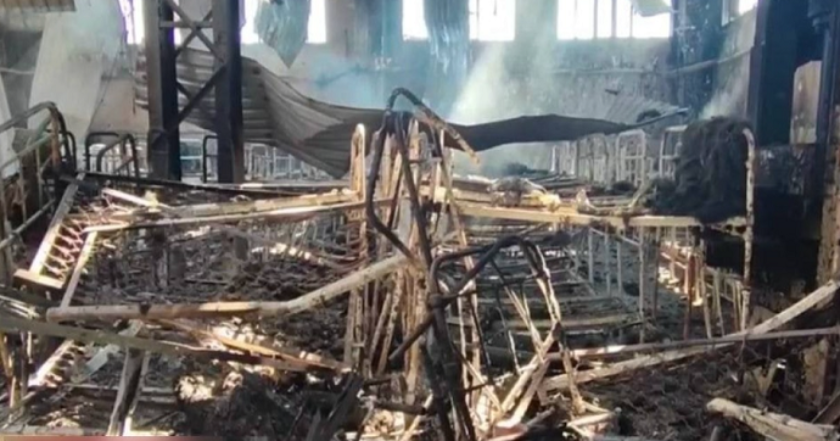CNN investigated and refuted russia's version of prisoners of war death in Olenivka

CNN, after investigating the events in the occupied Olenivka, where the captured defenders of Mariupol died in the colony at the end of July, came to the conclusion that the russia's version of the events about Ukrainians using HIMARS is most likely false
CNN reports about it.
"A CNN investigation based on analysis of video and photographs from the scene, satellite imagery from before and after the attack, and the work of forensic and weapons experts concludes the Russian version of events is very likely a fabrication.
There is almost no chance that a HIMARS rocket caused the damage to the warehouse where the prisoners were being held.
Experts the CNN consulted deny the HIMARS strike on Olenivka but can't say definitively what killed and wounded so many prisoners.
A lack of access makes definitive conclusions impossible. However, experts say most signs point to intense fire, and according to several witnesses, there was no sound of an incoming rocket," the publication said.
CNN journalists report that on July 28, more than 50 Ukrainian prisoners of war died in a detention center in the Donetsk region.
One of the leaders of the "DPR" militants, Eduard Basurin, said that Ukraine allegedly attacked so that the prisoners would not speak. Ukraine denies this, and CNN has also found no evidence of the russian version.
In the former penal colony in Olenivka, the invaders have held more than 1,000 prisoners since May. At the end of July, about 200 prisoners were moved to a separate building, where a severe fire broke out on July 28 around 11 p.m.
CNN analyzed the photos after the tragedy.
The walls and most of the roof remained intact. Experts say that a HIMARS strike would have caused much more damage. Inside there is evidence of an intense and extensive fire. People were burning in their beds.
On the morning of July 29, Andriy Lazarev, who works for the russian Defense Ministry's Zvezda channel, pointed to neatly put fragments, one of which had the serial number of a HIMARS missile in remarkably good condition despite the fire.
russian Defense Ministry spokesman Ihor Konashenkov said that the pre-trial detention center was hit by a missile "from the American HIMARS."
However, previous HIMARS strikes left craters visible in satellite images and extensive damage.
But not this time. CNN compared photos of the aftermath of the HIMARS strike on the warehouse in Nova Kakhovka and the aftermath of the fire in the Olenivka colony.
Several weapons experts told CNN that the images and video from Olenivka were inconsistent with a HIMARS attack.
Weapons expert Chris Cobb-Smith said the building, a warehouse with thin walls and a metal roof, would not have been left standing if hit by HIMARS.
"There is no crater anywhere in these videos; the beds did not move, the pillars are not damaged, but significant fire damage is visible.
If it had been a guided missile salvo fire system, you would have seen craters, broken ceilings and walls, and blown-up bodies. There are practically no signs of significant damage from the explosion on the building or on the bodies.
It appears that a large and intense fire caused the damage. Much of the damage to the roof also appears to have been caused by the fall of the roof rather than the impact of the projectile trajectory or the effect of the blast…
The remains of HIMARS were not photographed on site, which is surprising. A vital element of any investigation will be the collection of visual evidence of munitions remnants where they are found," Cobb-Smith emphasized.
US officials also rejected the idea of using HIMARS.
One official told CNN, "It was definitely not HIMARS."
"It is clear to our explosives experts that this was not an impact from the outside with an explosive substance. It is much more likely that the ignition started from the inside," another Western official emphasized.
Relatives of the prisoners of war say that the fighters in Olenivka did not hear the missile's impact.
In the SBU intercept, the militants said there were three explosions, but CNN cannot verify this. They also cannot verify the Ukrainian version about the use of thermobaric weapons by the invaders, such as "Bumblebee."
Multiple analysts told CNN that it made no sense for Ukraine to use a long-range HIMARS missile if it wanted to hit a building 15 km from the front line.
Moreover, it is expensive and easier to track than a Soviet-era missile from old stocks.
Two Ukrainian officials told CNN that the attack on Olenivka occurred just as they were expecting a prisoner exchange with russia.
The publication also notes that russian reporters were allowed to visit the prisoners in Olenivka a few days before the incident.
Read Rubryka's daily timeline of war: current news on Ukraine's defense against russia's aggression.



















































